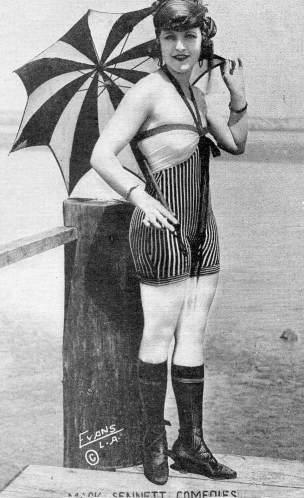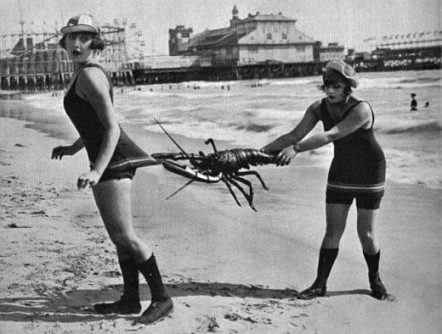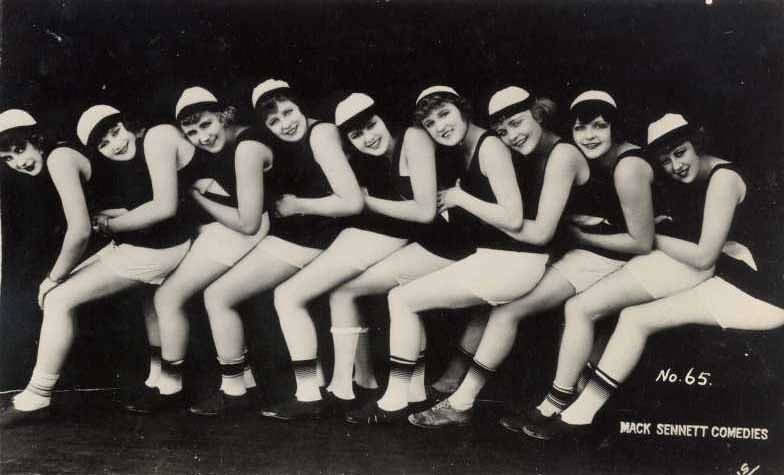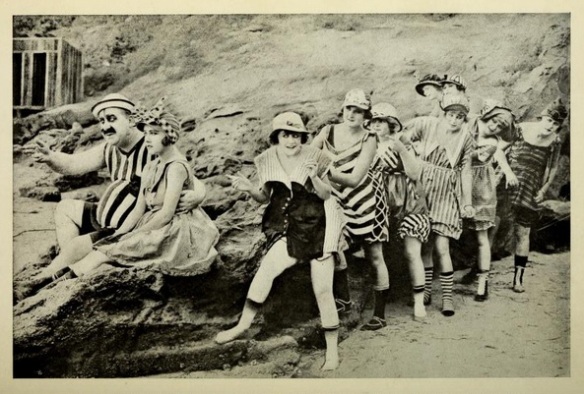If you’re ever having an earnest discussion about silent comedy (and who wouldn’t), there are a few topics that will often bring out a smile: fake mustaches, cream pies, satirical twirling of said fake mustaches, the Ton of Fun. And there’s one topic that always seems to make people smile: Mack Sennett’s Bathing Beauties.
Once considered mildly risqué, but now considered surprisingly innocent, the playful, perky, mischievous girls popped up in Sennett’s comedies time and time again. Admittedly the plots would sometimes screech to a halt just for them, but at least half of the theater audiences were too appreciative to mind.
The girls were shown doing exercises, playing games, dancing, running, arguing…any ol’ excuse would do, really, to serve the main purpose: to show off those slender 1910s-20s figures. And those figures were usually enhanced with the most chic and daring of modern bathing suits, resplendent with stripes, checks, ruffles or layers and often accompanied by dark stockings or a slightly startling hat.

Eye-catching! That is, aside from Chester Conklin.
So how did this idea for dressing up comedies with pretty young gals in bathing suits come about? To hear Sennett tell it, around 1914 inspiration struck in the form of a newspaper photo:
One morning as I went through the Times, I noticed a three-column picture on Page One of a pretty girl who had been involved in a minor traffic accident. The picture made the front page for two obvious and attractive reasons. The young lady’s knees were showing…I called in the staff. “Boys, take a look at this. This is how to get our pictures in the papers. Go hire some girls, any girls, so long as they’re pretty. Especially around the knees…“Get those kids on the screen,” I told our people. “Sure, I know they can’t act, but they don’t have to act. Put them in bathing suits and just have them around to be looked at while the comics are making funny.”
It’s a fun anecdote, despite the wisecrack about the gals not being able to act (yeah, Sennett was just padding his story, but let me assure you anyways: it’s not true). But it doesn’t quite explain the Beauties’ popularity and quick ascent to iconic status. By golly, it looks like a little historic background is in order! (I’m psyched.)
As most people know, around the 1900s women’s preferred bathing costumes were quite modest: a light wool dress that kept the upper arms and legs discreetly covered and light bloomers–often trimmed in ribbons and bows. We giggle at the supposed “repression” of them poor female bathers from the Days of Yore, but those swimsuits were simply the normal fashion of the time.

Man, just look how sad and repressed they are. (Circa 1908.)
Swimming was practically a national pastime for any American within range of the ocean. For instance, starting in the 1880s Coney Island rented out swimsuits to hundreds of bathers. In time cutting-edge young women began to wear more “daring” bathing suits, which also suited increased interest in swimming as a sport. Women had been competing in swimming competitions since at least the 1830s, but in the early 20th century interest grew fast–female swimmers even made their first appearance in the Olympics in 1912.
Smaller swimsuits probably also correlated with several trends: the desires of the much-discussed “New Woman,” the increased circulation of magazines and newspapers showing photos of fashionable young gals, the familiarity of chorus girls and burlesque performers onstage, and the popularity of fitness role models like Annette Kellerman.
Mack Sennett was very aware of these trends–as was his main actress, Mabel Normand. The two had worked together at Biograph, and Mabel had starred in Sennett’s first inklings of a “bathing girl” picture: Biograph short The Diving Girl (1911), where she was clad in a clingy black swimsuit. Normand was very athletic, and would happily show off her diving skills again in one of the Keystone Film Company’s very first releases, The Water Nymph (1912).
As time went on and Sennett’s Keystones grew in popularity, audiences began to notice that many of his films featured pretty actresses in the most daring of modern bathing suits. Soon he had a whole flock of these gals, referred to as the “Keystone bathing girls” or “Sennett’s bathing beauties.”
In 1917, Sennett joined Paramount and needed to give his studio a boost. He hit upon christening his flock the “Sennett Bathing Girls” (although “Beauties” would be used just as often) and using them in huge ad campaigns. He arranged for photo shoots with photographer Nelson Evans and started plastering the girls’ cheeky images everywhere he could–in magazine spreads, newspaper ads, theater lobbies, postcards, and arcade cards (which were pictures cards you bought from a coin machine, often at amusement parks).

One such card, from the Finding Nelson Evans blog.
Credit for the idea of promoting the Beauties was also claimed by Keystone director Eddie Cline. In 1917 he contributed to the World War I effort by making a split-reel film with a “waste not, want not” message informing people about overlooked food sources, such as fish. Cline decided that girls in bathing suits would help the noble message sink in, so he filmed some of the Keystone actresses fishing and cavorting in the water.
Whatever the case, the seeds for the Bathing Beauties had their roots in Sennett’s earliest films and Cline most certainly directed many films that prominently featured the Beauties, such as Hearts and Flowers (1919).
We’re all familiar with the general idea of the Bathing Beauties, but what were they like onscreen? Historian Brent Walker wrote in his Mack Sennett’s Fun Factory: “Their fun-loving, carefree antics in scanty bathing suits tweaked the noses of those viewers not prepared to dive headlong into the hedonistic Roaring Twenties just around the corner.” The lively girls tended to be in a group of up to ten or more, playing ballgames on the beach and poking fun at spooning couples. Films often set aside chunks of running time just for these shots, regardless of how well they served the plot. Walker described a typical Beauties scene: “In A Bedroom Blunder, the girls spy Eva Thatcher’s rump protruding from an upper-story window, and their collective instinct leads them to kick a beach ball at this inviting target without reservations.”
Sometimes the Beauties showed up in roles as run-of-the-mill as “cabaret girls” or as unique as “dancers engaged in Grecian outdoor dancing pursuits.” In one short, On a Summer’s Day (1921) a few of them appeared as “farmerettes.”
Many of the actresses making up Sennett’s Bathing Beauties had lower- and middle-class backgrounds, and didn’t necessarily have acting experience. Many of them entered films as a way to try and make their own living in that brave new era of the early 20th century.
So who were these actresses? Numerous “members” would fall in and out of the group from 1917 to the end of the ’20s. Some would one day become stars; many would remain obscure. Their ranks would include: Phyllis Haver, Juanita Hansen, Ora Carew, Mary Thurman, Sybil Seely, Roxana McGowan, Vera Steadman, Marie Prevost, Virginia Fox, Cecille Evans, Ruth Hiatt, Mildred June, Edith Roberts, Myrtle Lind, June Day, Harriet Hammond, Marvel Rea, Claire Anderson, Kathryn McGuire, Carole Lombard, Jane Allyn, Thelma Bates, Maude Wayne…and more.

Vera Steadman and possibly Gonda Durand in another promo for Whose Little Wife Are You?
You might notice that I left out a certain name: Gloria Swanson. Swanson had always, somewhat vehemently, insisted that she was never a Bathing Beauty–even though the Internet is full of photos of her in bathing gear (as this blogger pointed out). However…there’s some truth to her claim. In her first two Keystone films Gloria played “The Girl,” and by her third comedy she was starring alongside Bobby Vernon in A Social Cub (1916), the first in a series of Gloria/Bobby comedies. While several of the Beauties also had starring roles in Keystones (Phyllis Haver and Marie Prevost for instance), the Beauties in general tended to be a youthful, if impersonal, group–a group which Gloria was never a part of onscreen. The bathing suit images in question seem to be promos taken around the time of The Pullman Bride (1917), later doubling as arcade cards. So congrats, Gloria, what you said seems to be true…from a certain point of view.

Gloria, not being a Bathing Beauty.
In Los Angeles the Bathing Beauties were familiar faces in many town events. In September 1917 they took part in the Venice “bathing girls parade” where, it was reported, “nearly all the honors went to Keystone comediennes.” (Mary Thurman, Juanita Hansen, Maude Wayne and Marie Prevost walked off with the prizes.) Soon, the girls were familiar faces in magazines and theater lobby displays throughout the country. Other studios started to copy them–soon there were Fox Sunshine Girls, Christie Studios Bathing Beauties and Hal Roach Bathing Girls. But these imitators couldn’t ever quite touch the iconic status that Sennett’s gals had.
In 1919 several of the Beauties were taken on a national tour promoting the Sennett feature Yankee Doodle in Berlin (a pro-Allies, anti-German bit of comedy propaganda). Their stunts made headlines in the local papers, including one where two of the girls dropped 150,000 miniature Bathing Beauties photos from an airplane over Times Square.

Crowds form to see the Beauties in NYC (note the very large number of men’s hats!). Motion Picture News, Sept. 13, 1919.
The studio’s official magazine, Mack Sennett Weekly, did everything in its power to promote the girls’ various talents–their athletic skills, their fashion tastes, their business savvy. Sometimes the talents were created out of thin air. The various Beauties being athletic wasn’t enough–someone like Mary Thurman had to touted as being trained by “world famous athletes as Fred Kelly, the winner of the high hurdles at the Olympic Games of Stockholm.” Marie Prevost wasn’t just a surfer, she was “one of the most expert surf-board riders in California.” Ah, publicity stories!
All the Weekly‘s earnest talk of Beauties being athletic gems of New Womanhood was swell, and refreshing if you think about it, but let’s get real here. We all know these gals were popular mainly because of one thing: they were Edwardian era eye candy.

One of Evans’s more daring images (their legs are slightly astride).
They were the pinup models of the WWI generation, sighed over by countless young men and probably a few of their fathers too. The press often referred to them in “wink wink, nudge nudge” fashion. One wiseguy writer in a 1918 issue of Film Fun proclaimed:
Exhibitors noticed significant ticket sales for Keystone shorts that featured the Beauties, and were more than happy to cash in:
The girls were even immortalized in song, via Ray Perkins’s “Help! Help! Mr Sennett (I’m Drowning in a Sea of Love).”
 .And not only were they eye candy, but they were the whole candy aisle. If you’re wondering why the Beauties became iconic so quickly, it’s not just because of those mildly saucy bathing suits. This was a time, after all, when dancers and chorus girls were all over the stages and vaudeville shows were full of ballerinas, divers, and magician’s assistants in scanty wear. Seek and you could even find naughty postcards. People weren’t unacquainted with the female form, is what I’m saying, even if your average woman still dressed modestly. No, what set the Beauties apart from your everyday swimsuit-wearing film actress was that there was usually a ton of them in the frame at one time.
.And not only were they eye candy, but they were the whole candy aisle. If you’re wondering why the Beauties became iconic so quickly, it’s not just because of those mildly saucy bathing suits. This was a time, after all, when dancers and chorus girls were all over the stages and vaudeville shows were full of ballerinas, divers, and magician’s assistants in scanty wear. Seek and you could even find naughty postcards. People weren’t unacquainted with the female form, is what I’m saying, even if your average woman still dressed modestly. No, what set the Beauties apart from your everyday swimsuit-wearing film actress was that there was usually a ton of them in the frame at one time.

This “the more the merrier” approach made the Beauties memorable among the sea of young women in films. And it helped that many genuine talents rose from their ranks. Phyllis Haver was soon one of Sennett’s main comediennes. Marie Prevost went on to stardom in the ’20s. Sybil Seely, Virginia Fox, and Kathryn McGuire would all work in Buster Keaton’s films. The Beauties had proved to be a good training ground.
In 1927, Sennett was growing tired of promoting the Bathing Beauties. By that point they had started losing some of their “naughtiness,” since smaller swimsuits were becoming the norm. They were also over-familiar. By 1928 they had been phased out of Sennett’s films–gone, but not forgotten. Even today they’re fondly remembered as an essential component of the “good old days” of slapstick comedy.

If you need proof of how times, they are a-changin’, look no further than the Bathing Beauties and their outrageously charming 1910s bathing suits. Imagine any actress trying to cause a stir with a bathing suit today–unless it’s made of dental floss, no one will bat an eye. In fairness, we can admit that those Evans arcade photos helped pave the way for such indifference. There were many more pinup girls to come, not to mention the increasing availability of other risqué material.
And yet, when I watch a film with the Bathing Beauties and see them in their concealing (by today’s standards) outfits running on the beach and playing ball–young women doing things, being healthy, not just lounging provocatively like you see in some Pre-Codes–I smile, and then feel just a little sad. Has something been lost? The cliché would be to say “innocence,” and there are times when I admit I’m tempted.

—
My main source for this post, and all the others for Keystone Month, is Brent Walker’s masterpiece Mack Sennett’s Fun Factory. I’ve also benefited from many viewings of The Mack Sennett Collection, Volume 1.
Other sources:
I’m also indebted to Rob King’s The Fun Factory: The Keystone Film Company and the Emergence of Mass Culture, the source of details such as info from the elusive Mack Sennett Weeklys. King’s meticulous book examines the historic background and context behind the Keystone studio and its various tropes. The research is fantastic. I recommend it, although be forewarned that the writing is very academic.
A wonderful Facebook group, Mack Sennett’s Bathing Beauties, is chockful of rare images and interesting historic info. Go to the “About” section for a detailed list of every known Bathing Beauty.
Finding Nelson Evans is a detailed, informative blog devoted to the famous photographer, and is another great source of information on the Beauties.








Hi Lea. That was a nice romp on the sand with the Bathing Beauties/Girls. I like your point about how a lot of their effect comes from there being a lot of them. They are always fun to watch, even if they bring the story to a halt.
They were! And I can’t help laughing at how blatant the whole idea of the Beauties was–Sennett was basically saying “Guys like pretty girls in bathing suits, ergo, let’s have 15 pretty girls in bathing suits onscreen all at once.”
Excellent, as always! I’ve often wondered how much money Nelson Evans made from his bathing beauties photos. He was the head of Sennett’s stills department at the time and was given the rights to his photos. Great deal for him, not so much for Sennett! BTW, I believe you can see Evans at work in the bathing beauty outtakes on the Mack Sennett Collection. One of the shots from the rally/gathering with the ladies going across the stage shows the stage from the crowds pov. On the left side of the movie camera on the stage is a still photographer. The timing is right for it to be Evans, plus he’s very thin (on his draft registration card, Evans is described as having a slight build). Hard to tell for sure, but I think it’s a pretty good bet.
Good eyes–you just might be right! Will have to get out my copy and take a look. It’s impressive that he had all the rights to his photos when those Bathing Girl ad campaigns were so prolific. That wouldn’t fly for a big movie studio nowadays, that’s for sure!
Pingback: It’s Silent-ology’s 2nd Anniversary! | Silent-ology
Pingback: Obscure Films: “Hearts and Flowers” (1919) | Silent-ology
Excellent article! Would you have any information about Francesca “Frisco” DeVere? She was a Vaudeville performer and musical theatre actress (chorus mostly) who appeared in the Keystone Comedies and the Max Sennett productions…I am assuming she is one of the beauties you have pictured here.
Hi Kelly! There is no listing for anyone by that name in Brent Walker’s Sennett book, which is the last word on all things Sennett. So I’ve been looking around and haven’t found any information on anyone named Francesca DeVere, of any kind (that includes Google searches). Can I ask where you first heard of her? Did she maybe perform in films under a different name?
Reblogged this on Silent-ology and commented:
Being in the midst of preparing an article for the upcoming issue of The Silent Film Quarterly (have I mentioned that I have a column there now? No? Oh. Well, I do), I decided to do a repost of one of my favorite 2015 articles. It was written especially for Keystone Month, and was a lot of fun to write. Hope you enjoy!
Nice article—thanks for bringing it the forefront again! The bathing beauties are still beautiful… And congratulations on that column-dom!
Why thank you, it’s an exciting step!! 🙂
Pingback: Finding Marvel (my search for another Sennett Bathing Beauty) – Marvel Rea
Pingback: Eyes on the pies: how Mabel Normand, Chaplin’s mentor, changed cinema | Naija Upgrade
Pingback: Eyes on the pies: how Mabel Normand, Chaplins mentor, changed cinema | Palakpakin
Pingback: Irene Lentz – pioneer of an American luxury fashion brand
Pingback: Was Gloria Swanson Really A Sennett Bathing Beauty? | Silent-ology